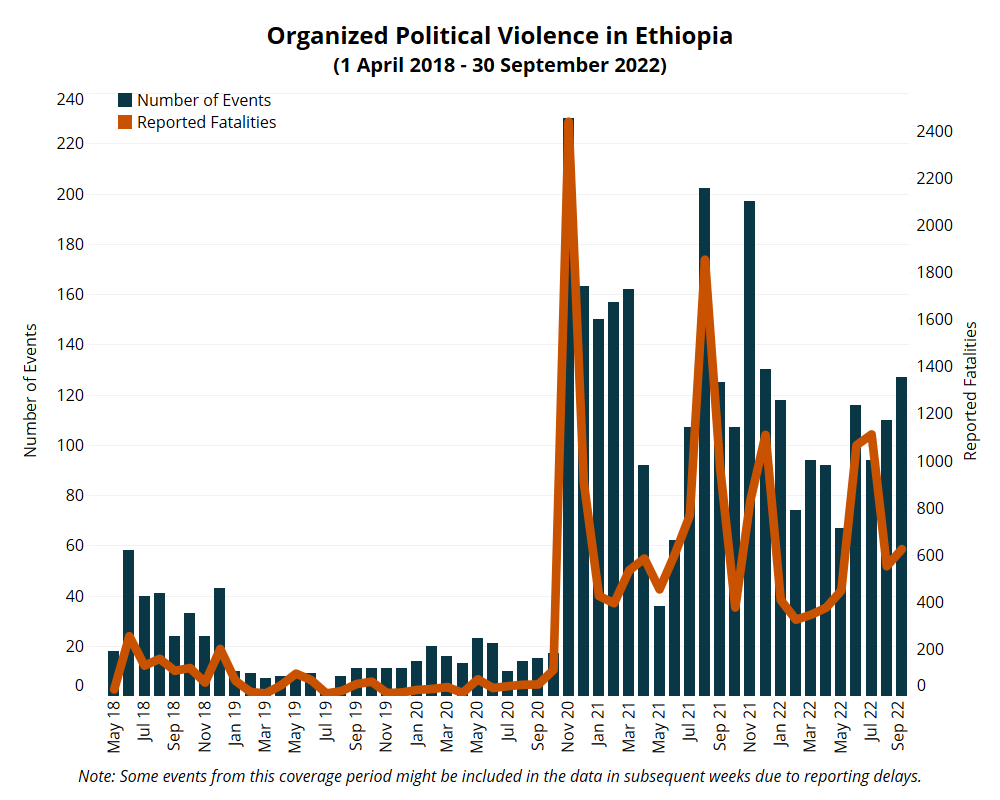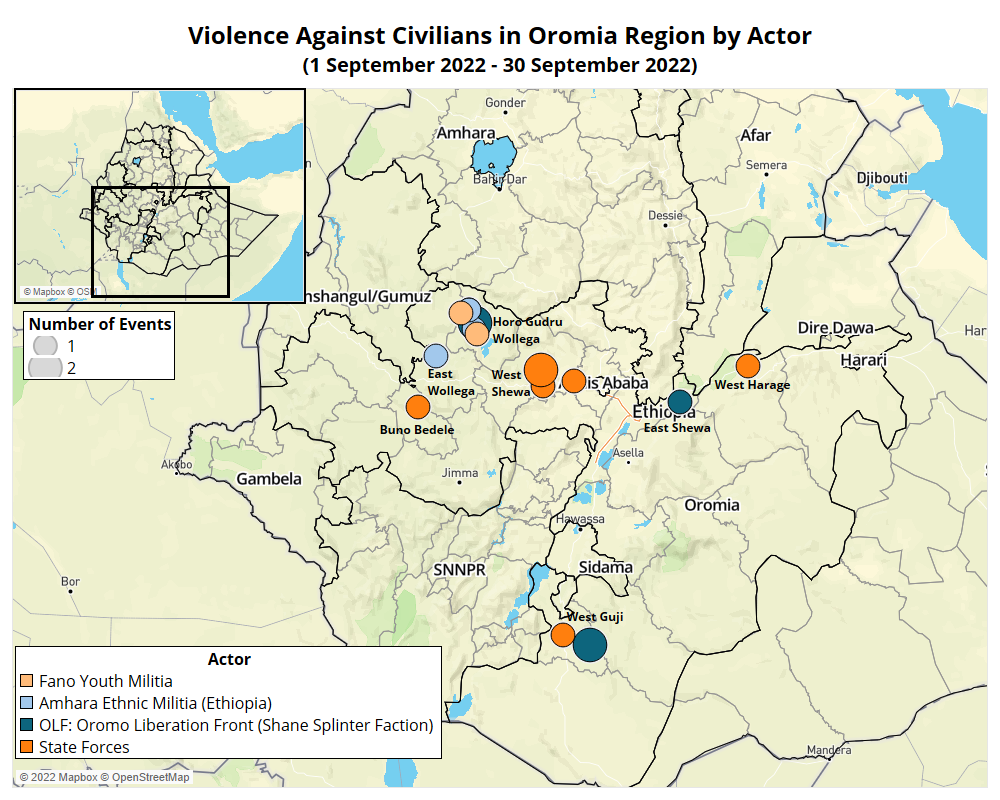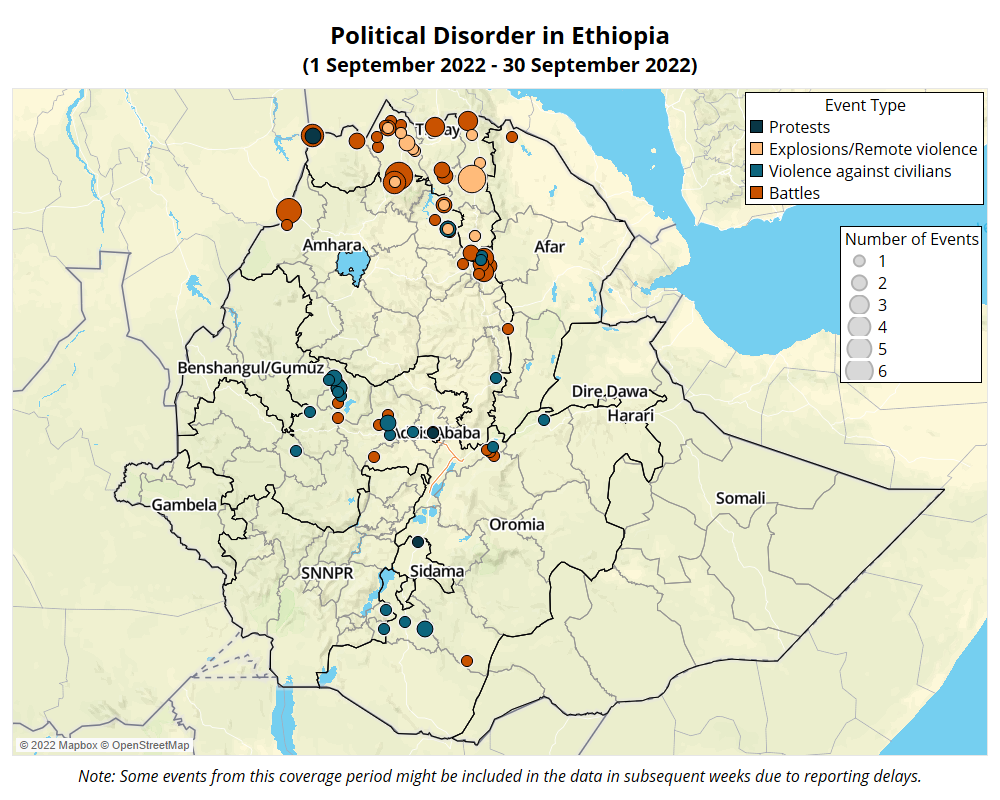September at a Glance
Vital Stats
- ACLED records 127 organized political violence events and 626 reported fatalities in September.
- Oromia region had the highest number of reported fatalities due to organized political violence, with 379 reported fatalities. Tigray region followed with 133 reported fatalities.
- In September, the most common event type was battles, with 80 events and 335 fatalities reported, followed by violence against civilians, with 29 events and 206 fatalities reported.
Vital Trends
- In September, armed clashes between government forces and the Tigray People’s Liberation Front (TPLF) continued in Afar, Amhara, and Tigray regions.
- The Ethiopian National Defense Force (ENDF) conducted drone strikes in Tigray region.
- The Oromo Liberation Front (OLF)-Shane and government forces – ENDF and Oromia regional special forces – continued to clash in Oromia region.
- Violence targeting civilians also continued in Oromia region.
In This Report
- September Situation Summary
- Monthly Focus: The Northern Ethiopia Conflict and the Terms of Possible Peace Negotiations

September Situation Summary
Last month, fighting and violence against civilians continued in various parts of Ethiopia. Most battle events – 66 – were recorded in northern Ethiopia, Afar, Amhara, and Tigray regions (see the monthly focus for more details on these events). The next highest number of battle events was recorded in Oromia region, with 13 events and 208 reported fatalities, the most of any region.
Oromia region is the second volatile area in Ethiopia, next to northern Ethiopia. Last month, OLF-Shane and government forces continued to fight in various areas of the region. In September, armed clashes between these parties were recorded in Arsi, East Shewa, East Wollega, Guji, Horo Guduru Wollega, South West Shewa, and West Shewa zones. By the end of the month, it was reported that OLF-Shane forces managed to take control of Jardega Jarte woreda in Horo Guduru Wollega zone. This area has been experiencing frequent attacks against civilians by both the OLF-Shane and Amhara and Fano militias. Since 22 September, attacks on civilians and armed clashes between OLF-Shane and government forces have been reported in Jardega Jarte and Amuru woredas (see EPO Weekly: 24-30 September 2022 and EPO Weekly: 17-23 September 2022 for more details on these events).
In September, ACLED recorded 18 violence against civilians events with 171 reported fatalities in Oromia region, including the attacks in Horo Guduru Wollega zone. Perpetrators of these attacks were the OLF-Shane, government forces – the ENDF, Oromia regional special forces, and kebele militias – and Amhara and Fano militias (see map below). The OLF-Shane was involved in six violence against civilians events, killing over 75 civilians. Most of the attacks by the group were recorded in Horo Guduru Wollega zone last month. Most of the Amhara and Fano militias attacks on civilians were also recorded in the same zone. Last month, five violence against civilians events with over 75 reported fatalities by Amhara and Fano militias were recorded in total; three of them were in Horo Guduru Wollega zone, and the remaining two were in East Wollega zone (see EPO Weekly: 24-30 September 2022 for more details on the latest events in Horo Guduru Wollega zone). Government forces were involved in seven attack against civilians events resulting in 21 reported fatalities overall – with the majority occurring in West Shewa zone.

OLF-Shane forces were also involved in events that occurred in Amhara and Southern Nations, Nationalities and Peoples regions (SNNPR). On 18 September, members of the OLF-Shane opened gunfire on farmers looking after their cattle in Awranje kebele in Burji special woreda, killing two farmers and injuring another. The group also killed around 30 cattle. Three days later, on 21 September, an unidentified armed group from West Guji in Oromia region — suspected to be the OLF-Shane – opened fire on civilians who were waiting for nine visiting members of the House of Representatives. These representatives were assigned to investigate identity-based attacks on members of the Kore ethnic group in Melka Oda village in Dorbale kebele in Amaro special woreda (DW Amharic, 22 September 2022). Due to this attack, five civilians were killed, while four others were injured.
In Amhara region, the OLF-Shane clashed with Amhara regional special forces, Amhara regional state police, and Amhara ethnic militias in Burka, Warsamet, and Kara Daka areas in Dewa Harewa woreda in Oromia special zone.
Lastly, on 21 September, an unidentified armed group from South Sudan opened fire from Maluwal Gaot area on the South Sudanese side of the border, targeting a motorboat transporting civilians from Jakawo bridge to Metehar town on Baro river in Nuer zone in Gambela region. The armed group reportedly opened fire over disputes related to tax payments. One person was killed, and seven others were injured due to this attack.
Monthly Focus: The Northern Ethiopia Conflict and the Terms of Possible Peace Negotiations
One month has passed since the resurgence of armed clashes between TPLF and government forces in northern Ethiopia. The clashes occurred after five months of relative calm following the declaration of a humanitarian truce on 24 March. Both conflicting parties have accused one another of initiating the new round of armed clashes (FDRE Government Communication Service, 24 August 2022; Twitter @TigrayEAO, 24 August 2022).
The fighting between the two parties began in North Wello zone in Amhara region, Southern Tigray zone in Tigray region, and Fanti Rasu-Zone 4 in Afar region, and quickly spread to other parts of Amhara and Tigray regions, including Wag Hamra and North and West Gondar zones in Amhara region, as well as North Western Tigray, Central Tigray, Mekelle, and Eastern Tigray zones in Tigray region (see map below). Armed clashes between government forces and TPLF forces and TPLF-affiliated armed groups like the Samri youth militia were reported last month in areas near the border between Ethiopia and Sudan in both Amhara and Tigray regions. Eritrean Defence Forces (EDF) and TPLF forces are understood to be engaged in fierce clashes in the north of Tigray region, although little information is being reported.

Preconditions for Negotiations
On Ethiopian New Year, 11 September, the TPLF accepted the African Union (AU)-led peace negotiations with the federal government (Twitter @TigrayEAO, 11 September 2022). Previously, the TPLF had put forward a list of preconditions to be fulfilled by the federal government before sitting at the negotiation table (see EPO Weekly: 3-9 July 2021 for more details on the list of preconditions released by the TPLF). Moreover, the TPLF had previously rejected the government proposed peace negotiations led by the AU High Representative for the Horn of Africa, Olusegun Obasanjo (The Africa Report, 22 August 2022; Tigray TV, 18 August 2022).
Weeks before the recent round of fighting erupted, there were press statements regarding the issue of restoring communications and basic services in Tigray region by both the TPLF and the federal government. The TPLF put the issue of Western Tigray, restoring communications and basic services, including electricity and bank services, on its list of preconditions for negotiations. The TPLF also asked for the restoration of these services by sending a letter to the federal government through the US and EU Special Envoys for the Horn of Africa, “providing security guarantees for those who need to work to restore services” (US Embassy in Ethiopia, 2 August 2022). The federal government responded by saying that there “is no off and on button that is centrally located” to restore these services in Tigray, and detailed the process to restore damaged equipment, including the need for different institutions like the Ethio Telecom to be physically present with their offices open and operational in the region (Office of the Prime Minister – Ethiopia, 18 August 2022). Additionally, the government released a list of civil servants and employees allegedly killed by the TPLF while attempting to restore services in Tigray (Ethiopia Current Issues Fact Check, 8 September 2022).
The restoration of services has acted both as a precondition for negotiations as well as a reason to resume the conflict. The TPLF had repeatedly indicated that it would use force if needed to break the siege against Tigray region and restore communications and basic services in the region. The US Special Envoy for the Horn of Africa, Mike Hammer, stated that during his visit to Tigray on 2 August, TPLF leaders informed him that their forces were ready to wage war if communications and basic services were not restored by the federal government (Africa Regional Media Hub, 20 September 2022).
In June 2022, the federal government selected and appointed a peace committee led by Deputy Prime Minister Demeke Mekonen and approved the AU-led peace negotiations. The government insists that peace talks must be held without any preconditions. Yet, prior to 11 September, the TPLF pressed for peace talks not led by the AU.
The Terms of the Possible Peace Talks
The conflicting parties will likely discuss five main issues – Western Tigray zone, banking and communication services,1The government clearly stated that these issues should be discussed at the negotiation table (Office of the Prime Minister – Ethiopia, 18 August 2022) while the TPLF put these issues on its list of preconditions (see EPO Weekly: 3-9 July 2021 for the original list of TPLF preconditions). Tigray secession, the withdrawal of non-Tigrayan forces, and the status of Tigrayan armed forces and the TPLF. In February 2022, Debretsion Gebremichale, the Chairman of the TPLF, listed the non-negotiable issues for the TPLF (VOA Amharic, 18 February 2022; BBC, 4 February 2022; BBC Amharic, 19 February 2022). These issues include the withdrawal of non-Tigrayans forces – Amhara regional forces and Eritrean forces – from Tigray region, a referendum for Tigray secession, and the continuation of Tigrayan armed forces (see EPO Weekly: 3-9 July 2021 and EPO Monthly: February 2022 for more details on these issues).
Western Tigray zone – Welkait, Humera, and Tsegede areas – is currently administered by the Amhara regional government. Bordering Sudan, it is pivotal for both the TPLF and the federal government to control these areas; the government needs to have full control over its international borders, and in line with ethno-federal arrangements throughout the country, the zone’s ethnically heterogenous population of both Amharas and Tigrayans can request recognition and distinct territorial administrations for their ethnic groups. At the outset of the Tigray conflict, Amhara regional forces took military control of these areas, establishing an administration loyal to the Amhara regional government. Western Tigray zone has been contested for the last 30 years. The area became part of Tigray region after the implementation of ethno-federalism by the TPLF-led Ethiopian People’s Revolutionary Democratic Front (EPRDF) – the ruling party from 1991 to 2019. Amharas living in these areas sought reassociation with Amhara region during that time (Foreign Policy, 28 April 2021; Amhara Media Corporation, 8 July 2021). The TPLF, however, insists that Western Tigray should remain part of Tigray region. For residents of Amhara region, Western Tigray has become a nationalist rallying cry; rumors of a possible armed response are common across Amhara should the government return the area to the TPLF (see EPO Weekly: 3-9 July 2021 and EPO Monthly: February 2022 for more details).
The federal government could request a demobilization and disarmament of Tigrayan armed forces – Tigrayan Defense Forces (TDF) – in the negotiations. The TPLF, however, has stated that the status of its forces is non-negotiable. Current reports indicate that the EDF is involved in the conflict in support of the federal government, with Eritrea mobilizing its armed forces and “reservists” under the age of 60 to fight in northern Ethiopia (Reuters, 17 September 2022). An armed Tigray region represents an active threat to Eritrea and Amhara and Afar regions and therefore it is unlikely that the government accepts the continuation of Tigrayan armed forces.
Moreover, the status of the TPLF could be another issue at the negotiation table. The federal government might request that the leaders of the TPLF surrender and be brought to justice. This, just like the previous issues, is thought by the TPLF to be non-negotiable. Some suggest the best option might be exiling TPLF leaders (Borkena, 11 January 2022). This might be considered problematic by the federal government in fear of the group reorganizing and attacking Ethiopia from neighboring countries as well as continuing to support armed groups in the country. The federal government blames the TPLF for supporting various armed groups in Ethiopia, including the OLF-Shane.
A referendum for Tigray secession has both political and legal complications. The federal constitution allows for any region, group, or territory to seek secession at any time. For example, some residents of Raya in Southern Tigray zone, Welkait, Humera, Tsegede areas in Western Tigray zone, and some kebeles in Eastern Tigray zone have spent two decades attempting to join neighboring regions. Before initiating the secession process, politicians from contested areas have to resolve identity-based demands to avoid further conflict. Additionally, according to the federal government, Tigray region does not have a legitimately elected legislative council. Even though the TPLF held a regional election in September 2020, it was not in compliance with the country’s electoral rules (see EPO Weekly: 13-19 November 2021 for more details on the potential of Tigray secession). This is a legal loophole through which a secession referendum can be refused at first, but it is unlikely to settle the matter.
Additional Complications
Questions about the most recent clashes concern who would benefit from initiating conflict as peace talks were being organized. The period before the new outbreak of armed conflict in August may have suggested that the federal government was vulnerable because of a possible breakdown in the federal government and support from Amhara region-linked forces like Fano militias and Amhara ethno-nationalists. Despite a fierce defense of their region during the November to December 2021 operation against TPLF forces, the Amhara-affiliated armed groups have fallen out of favor. In May 2022, the federal government and Amhara regional government undertook a “law enforcement operation” against the groups which, according to the government, were “operating under the Fano name” (Amhara Media Corporation, 19 May 2022; Amhara media Corporation, 21 May 2022; Amhara Media Corporation, 23 May 2022).
This law enforcement operation resulted in thousands of people being arrested, and clashes between armed groups operating under Fano and government forces in some areas of Amhara region (for more details on these arrests and armed clashes, see EPO Weekly: 14-20 May 2022 and EPO Weekly: 21-27 May 2022). This crackdown on Amhara ethno-nationalist actors, journalists, and individuals throughout Amhara region signified a new low in the relationship between Amhara ethno-nationalists and the Amhara regional government. Because this operation was commonly believed to be a government’s attempt to dismantle Fano militias, many anticipated that if another round of conflict erupted, Fano militias and Amhara nationalists might not cooperate with the federal government again. Despite this assumption, the ENDF, Amhara regional special forces, and Fano and Amhara militias are fighting as a coalition against TPLF forces in Amhara and Tigray regions.
Tensions at the border may have indicated another federal vulnerability. Armed clashes between the ENDF and TPLF and its affiliated armed group were reported at the border of Ethiopia and Sudan (see the details of these clashes in EPO Weekly: 13 August-9 September 2022 and EPO Weekly: 10-16 September 2022). One report indicated that Sudanese forces were also assisting the TPLF, and TPLF forces were fighting from Tumeta Medoka area in Sudan (EMS, 14 September 2022). Another report suggested that a number of TPLF soldiers involved in the armed clashes at the Ethiopia and Sudan border are reportedly former Tigrayan ENDF members who had refused to return to Ethiopia, having sought asylum in Sudan after serving with the UN peacekeeping mission in Abiye, a disputed border area between Sudan and South Sudan (Bloomberg, 2 September 2022). The UN High Commissioner for Refugees (UNHCR) recently disclosed that forced military recruitment was taking place at refugee camps in eastern Sudan, where Tigrayans have been taking refuge since the beginning of the northern Ethiopia conflict in November 2020 (Sudan Tribune, 7 September 2022).
Recent reports indicate that the TPLF and the federal government met face to face three times – once in Seychelles and two times in Djibouti (EUSR Mission to Ethiopia, 16 September 2022). The content of these meetings is not public, but according to the US Special Envoy for the Horn of Africa, a lack of trust continues to plague the talks (Africa Regional Media Hub, 20 September 2022). It is assumed that the AU and the international community are working together to build trust between the two sides. Until then there is a high probability for the armed conflict to continue in northern Ethiopia.
Visuals in this report have been updated for clarity.






